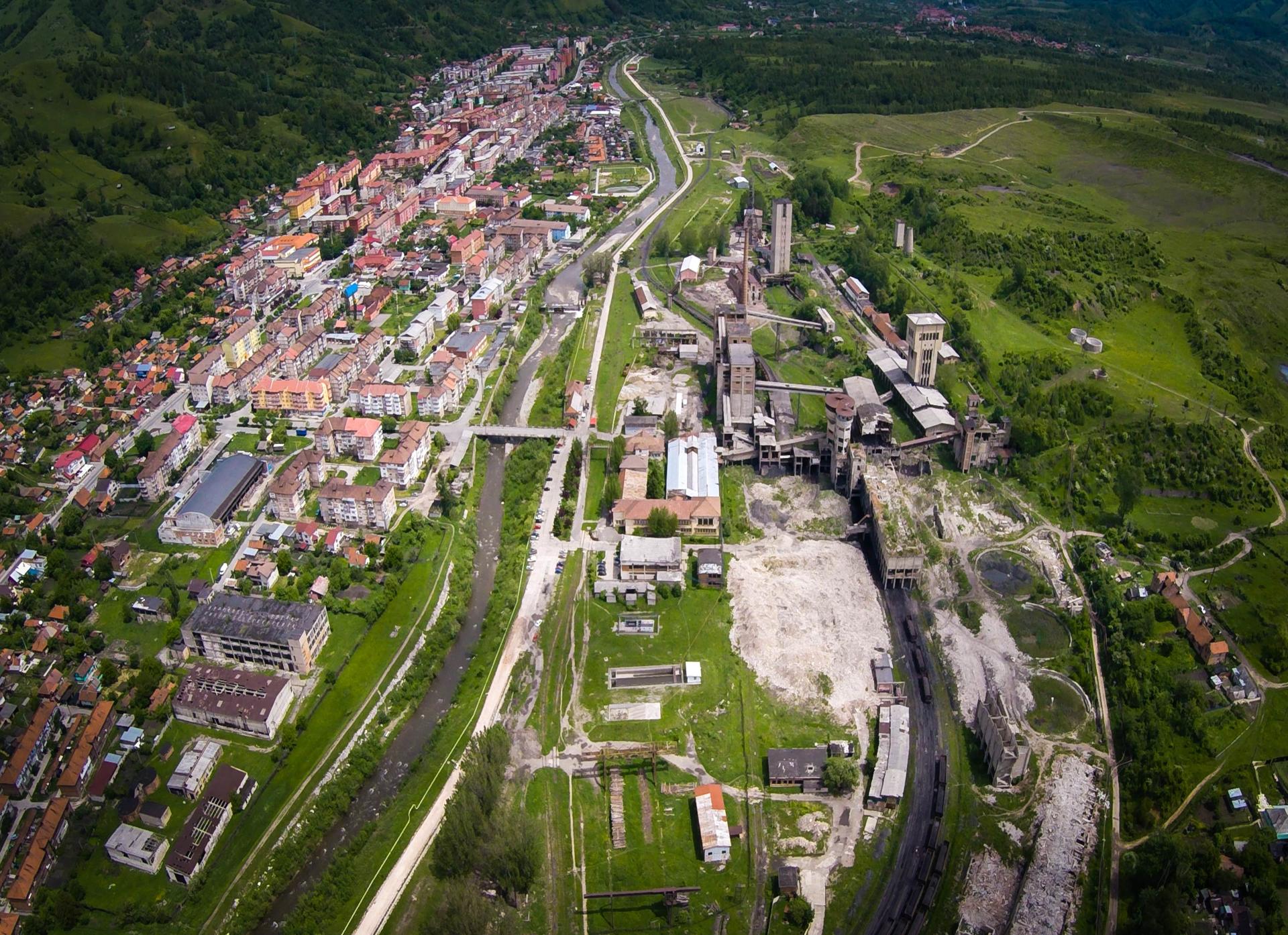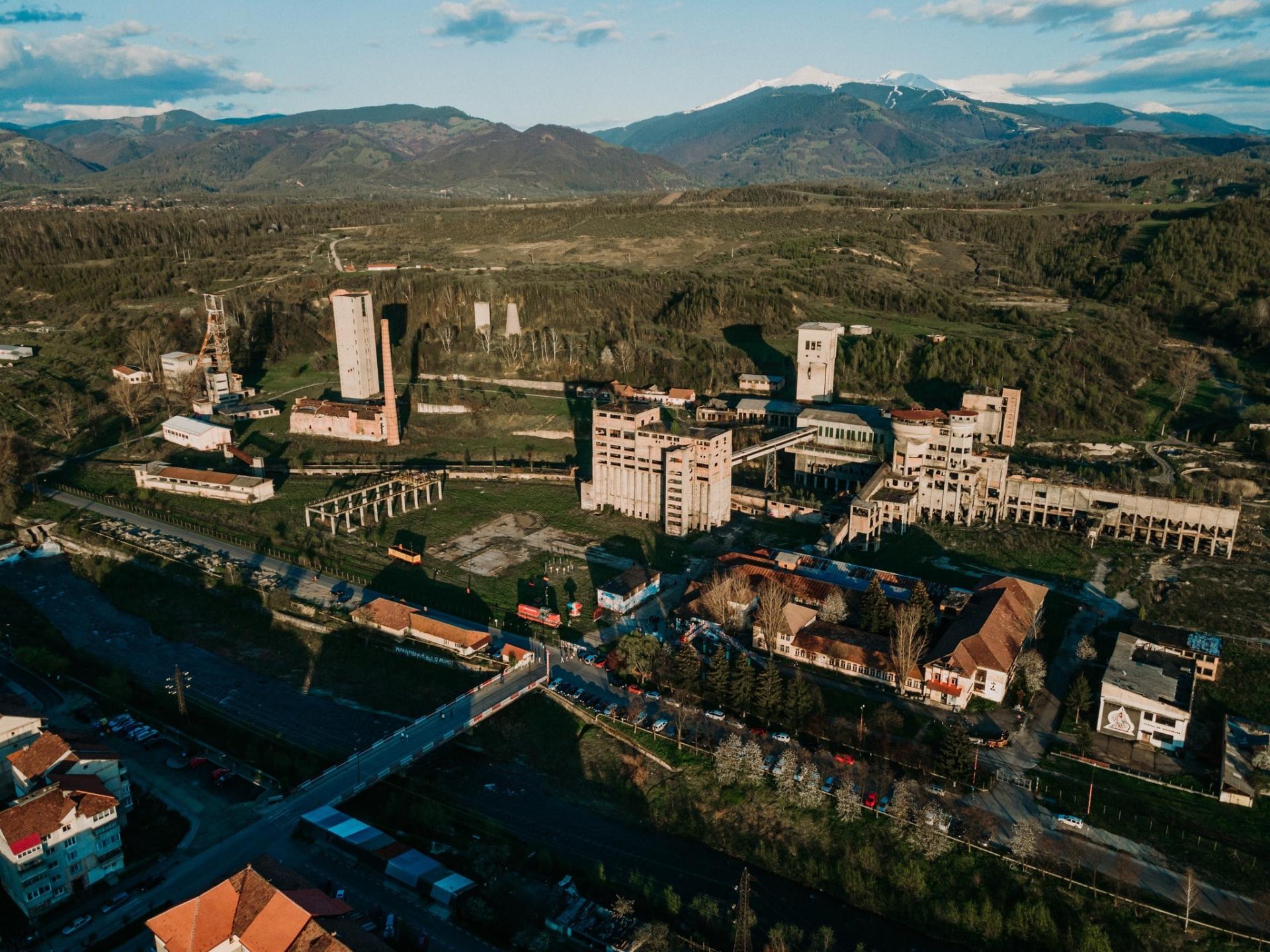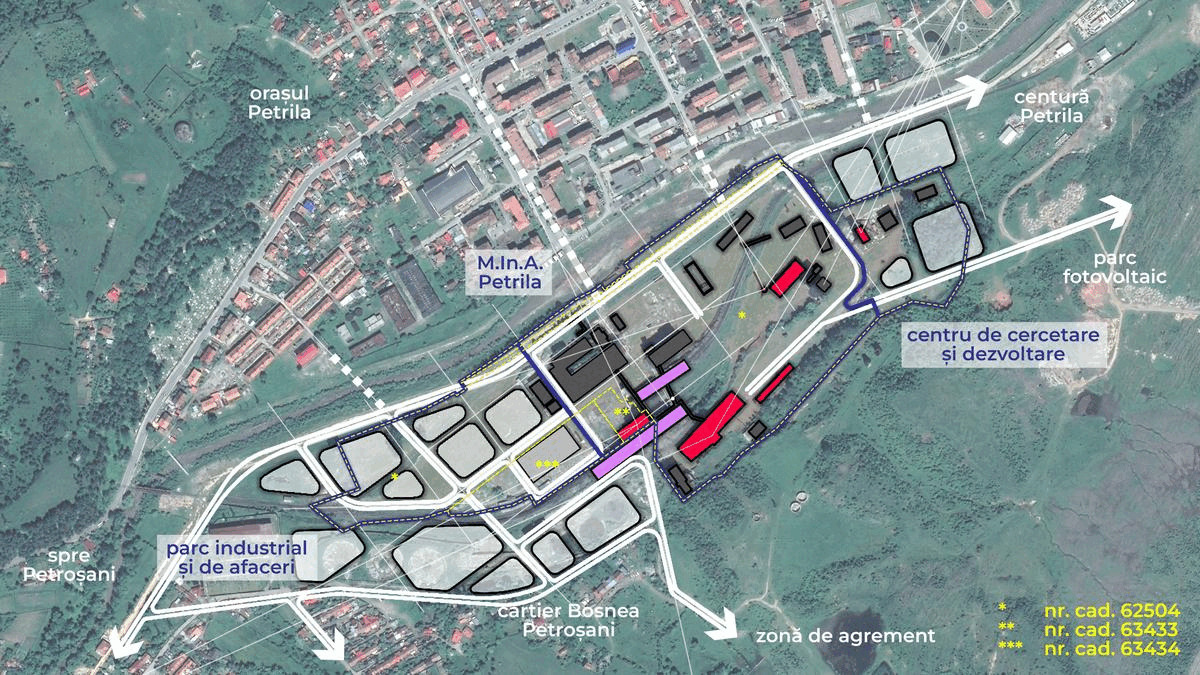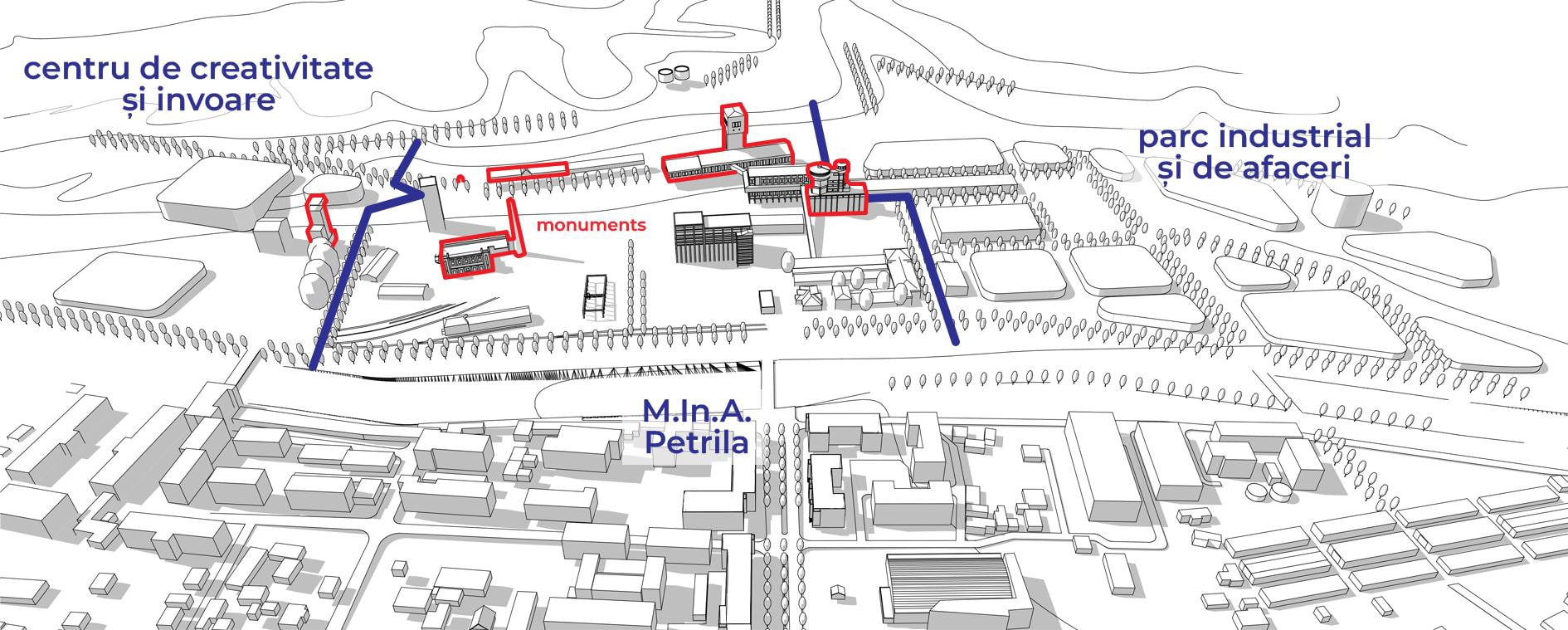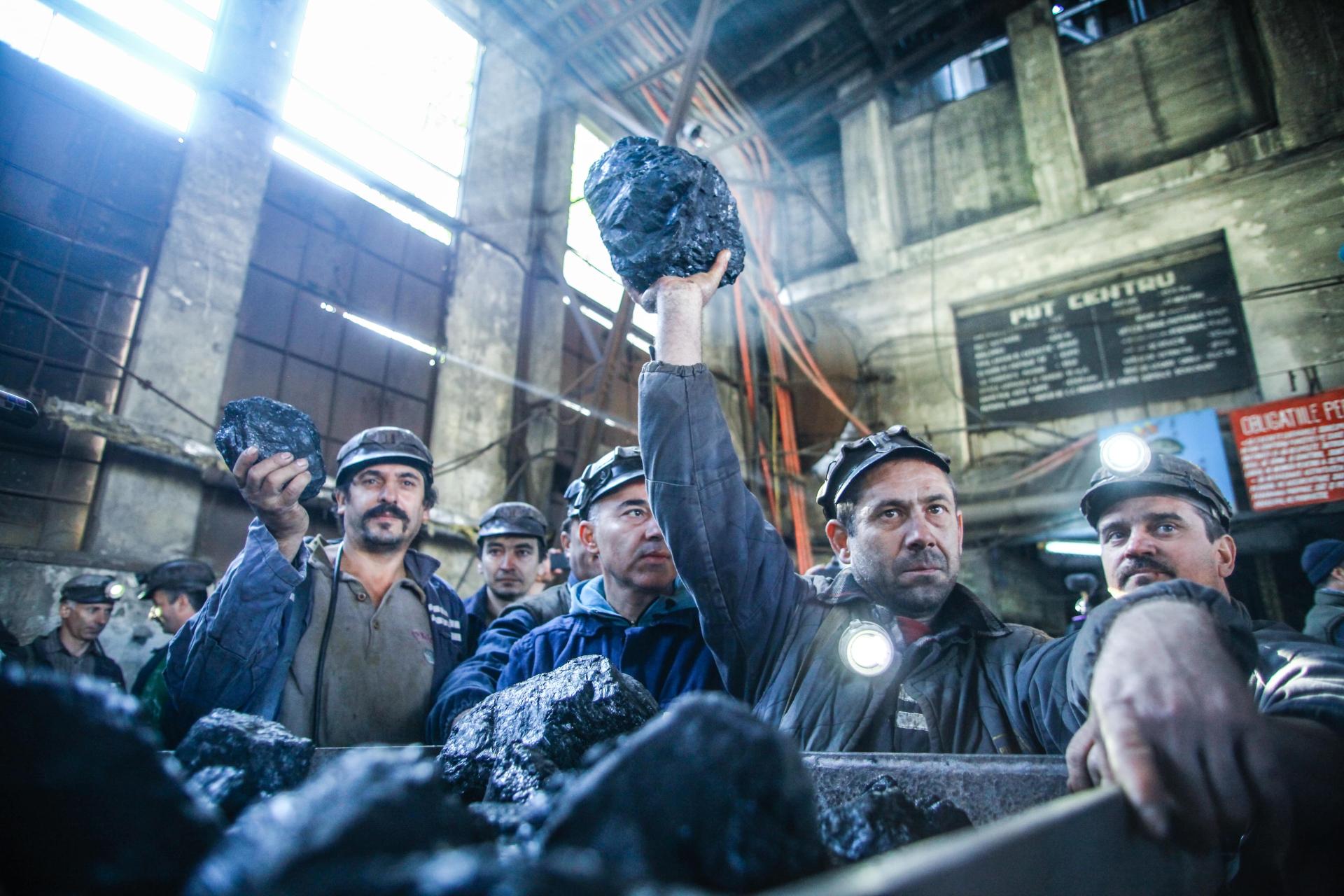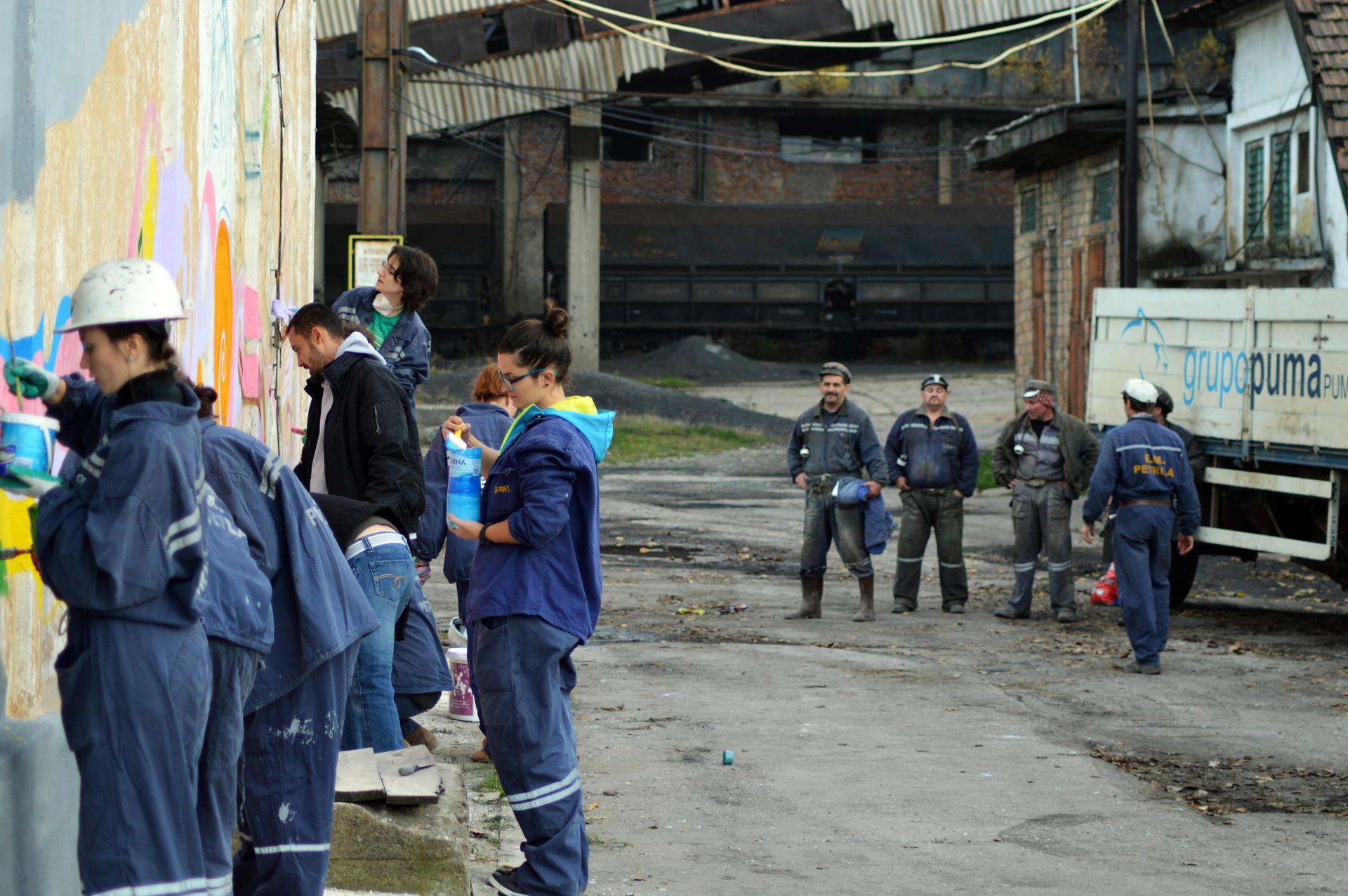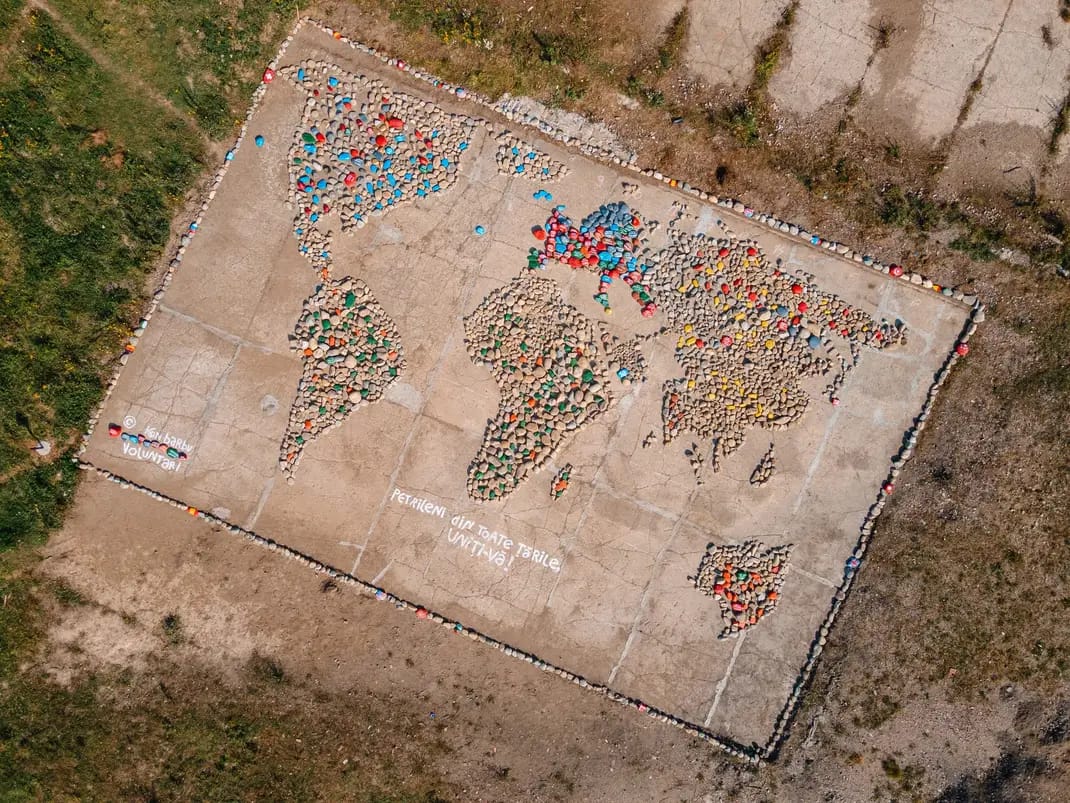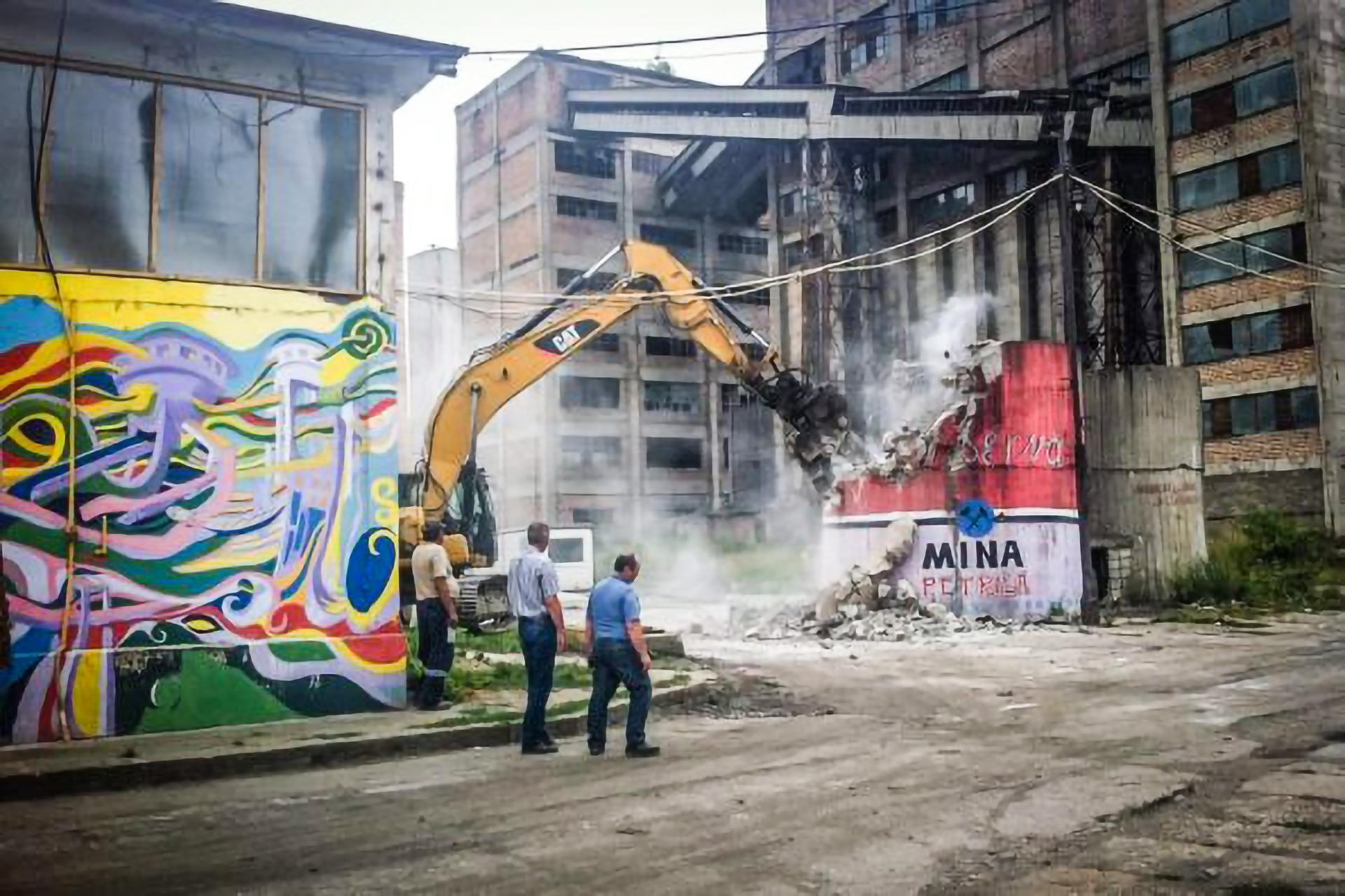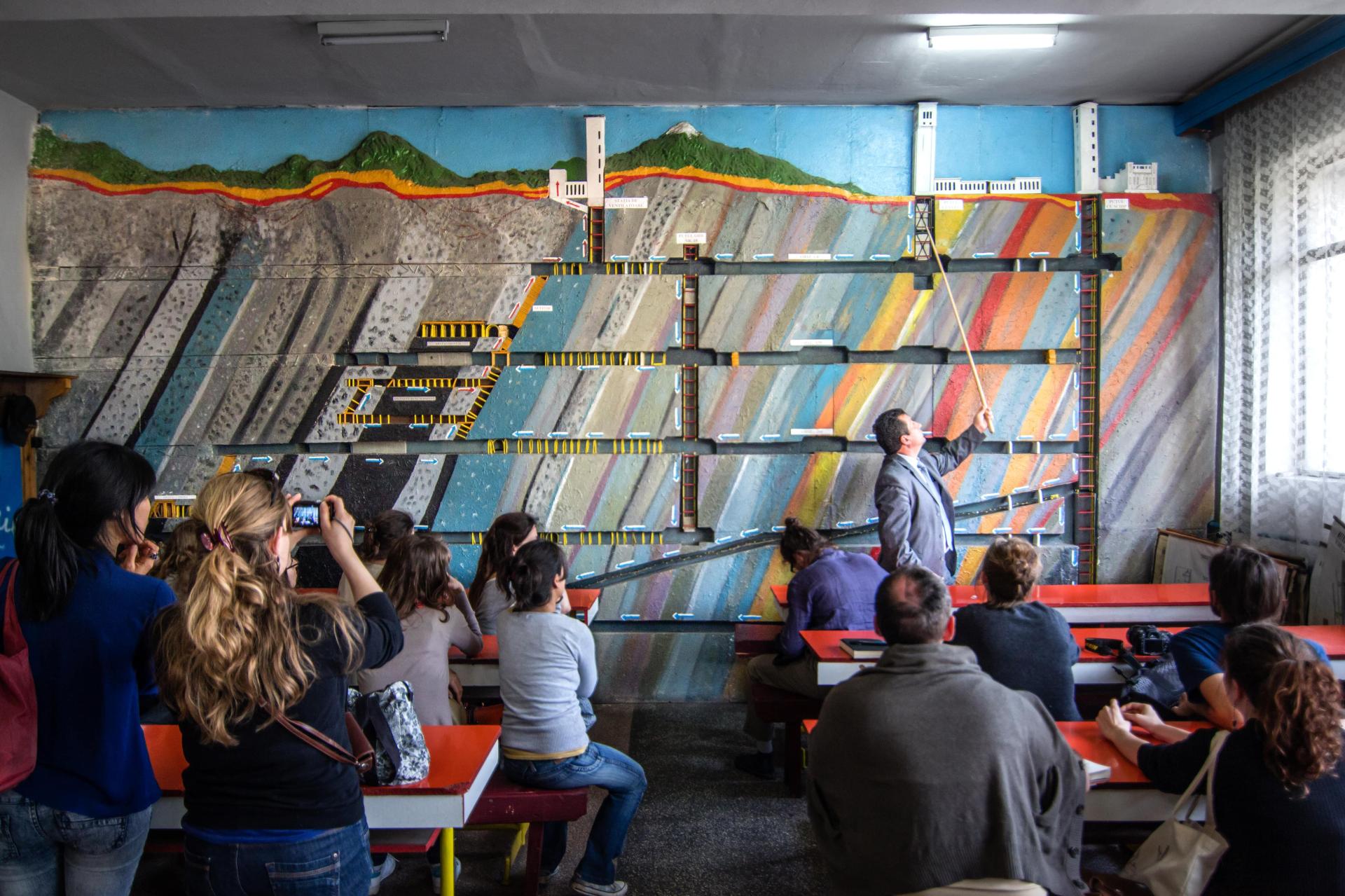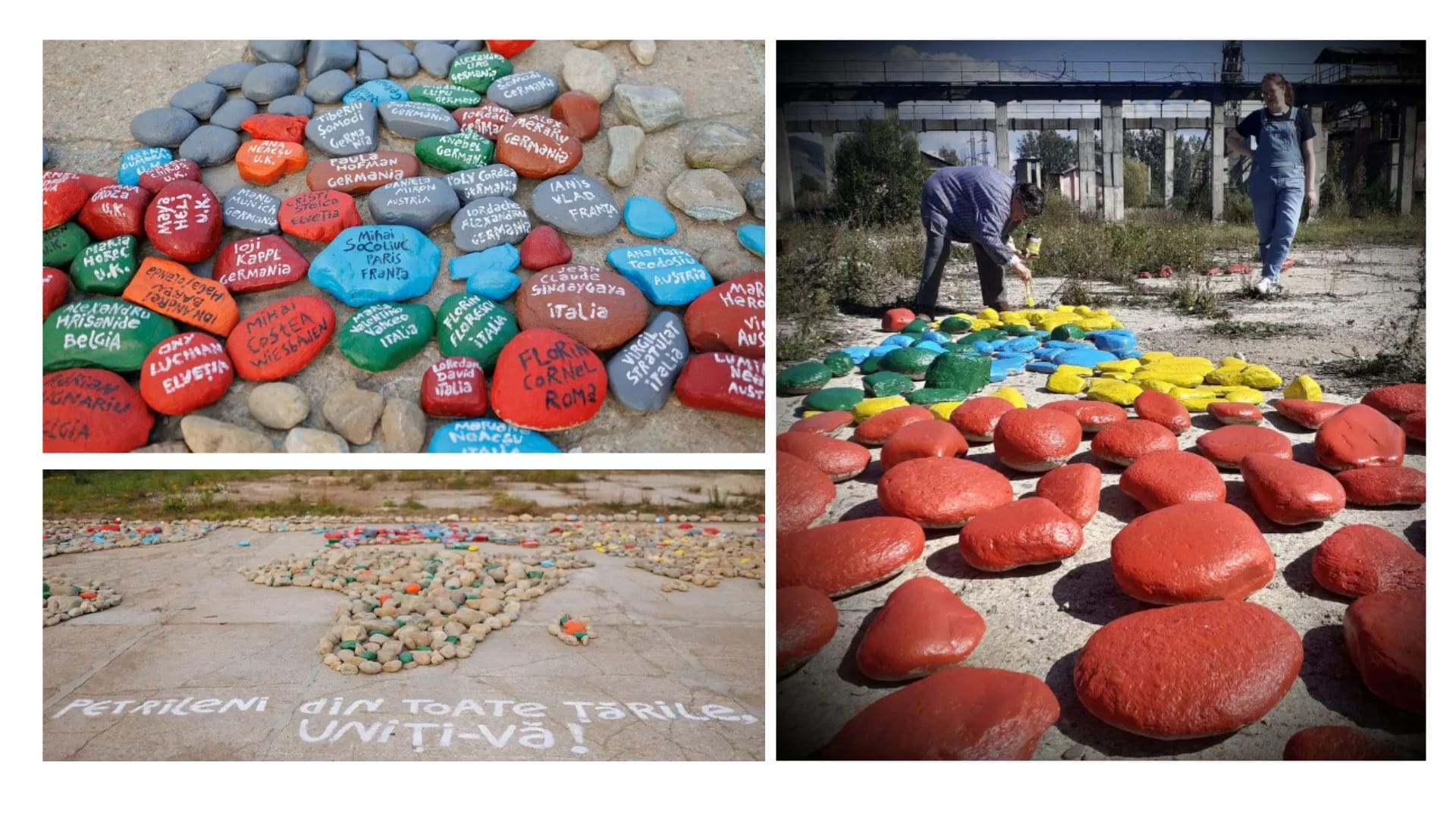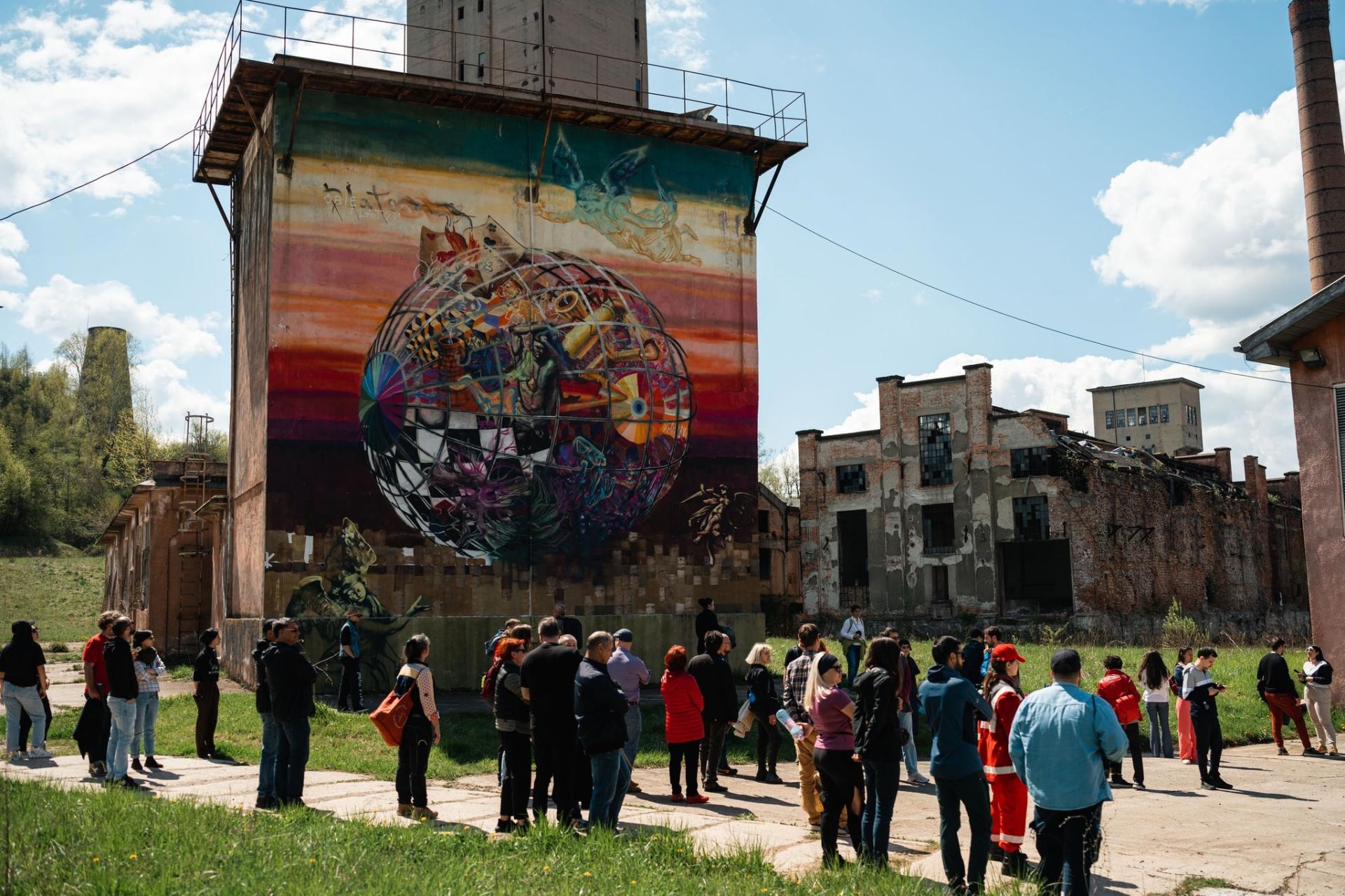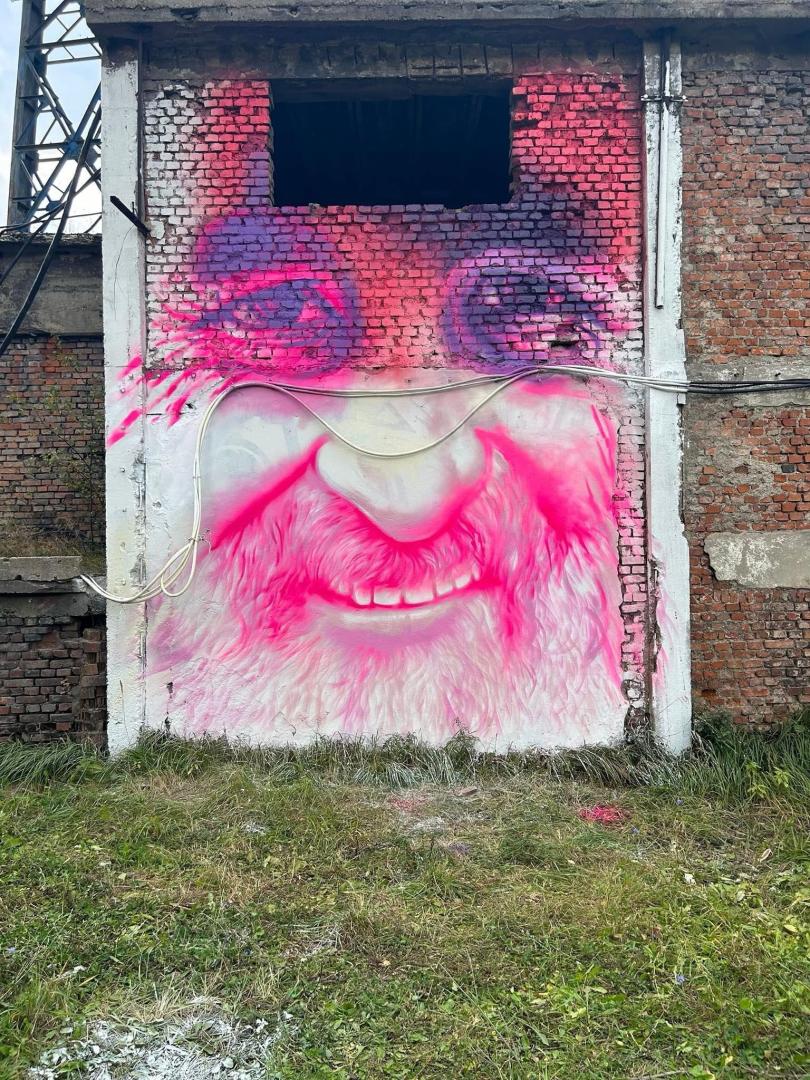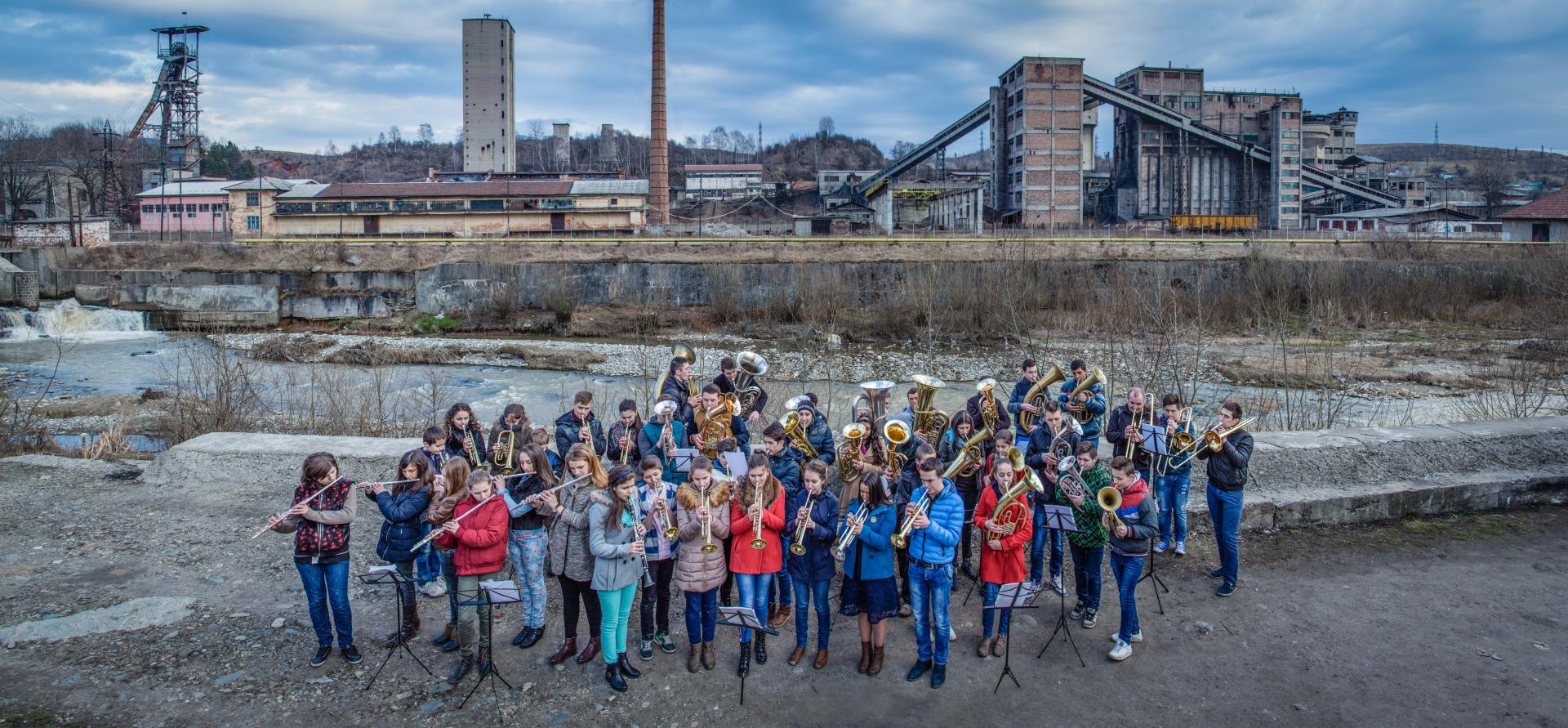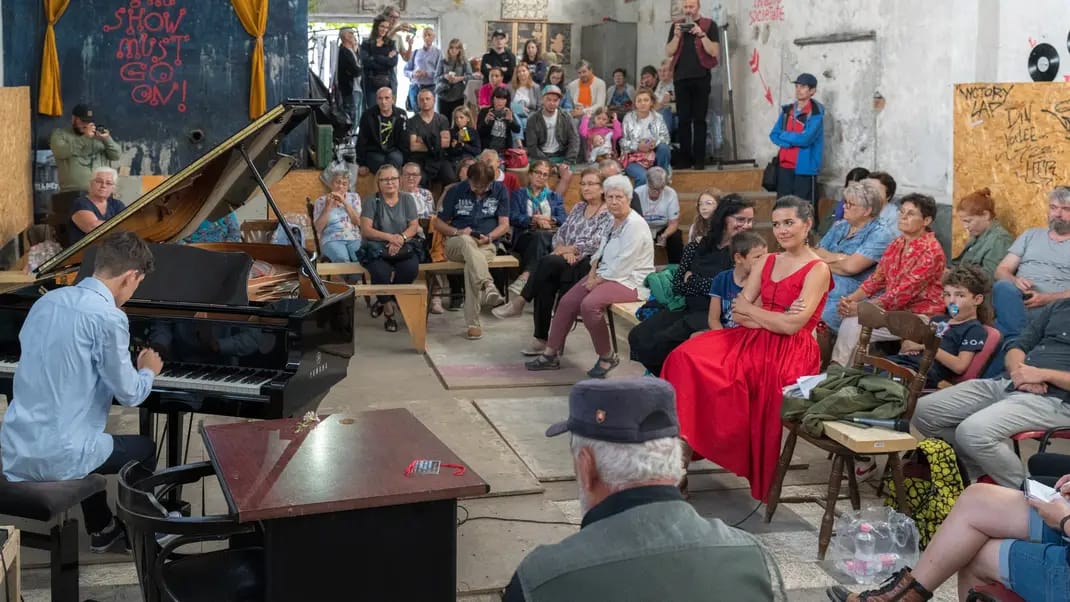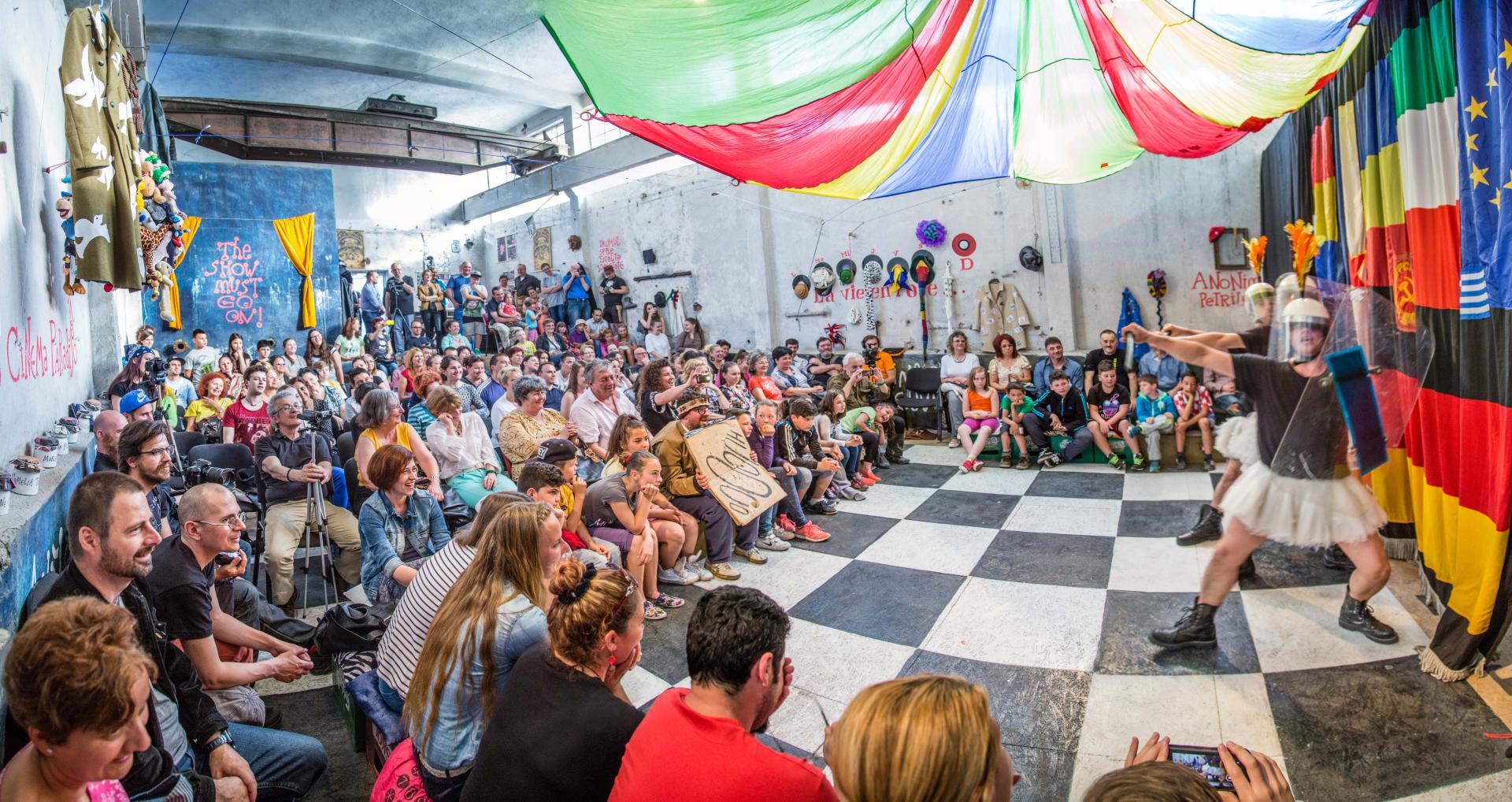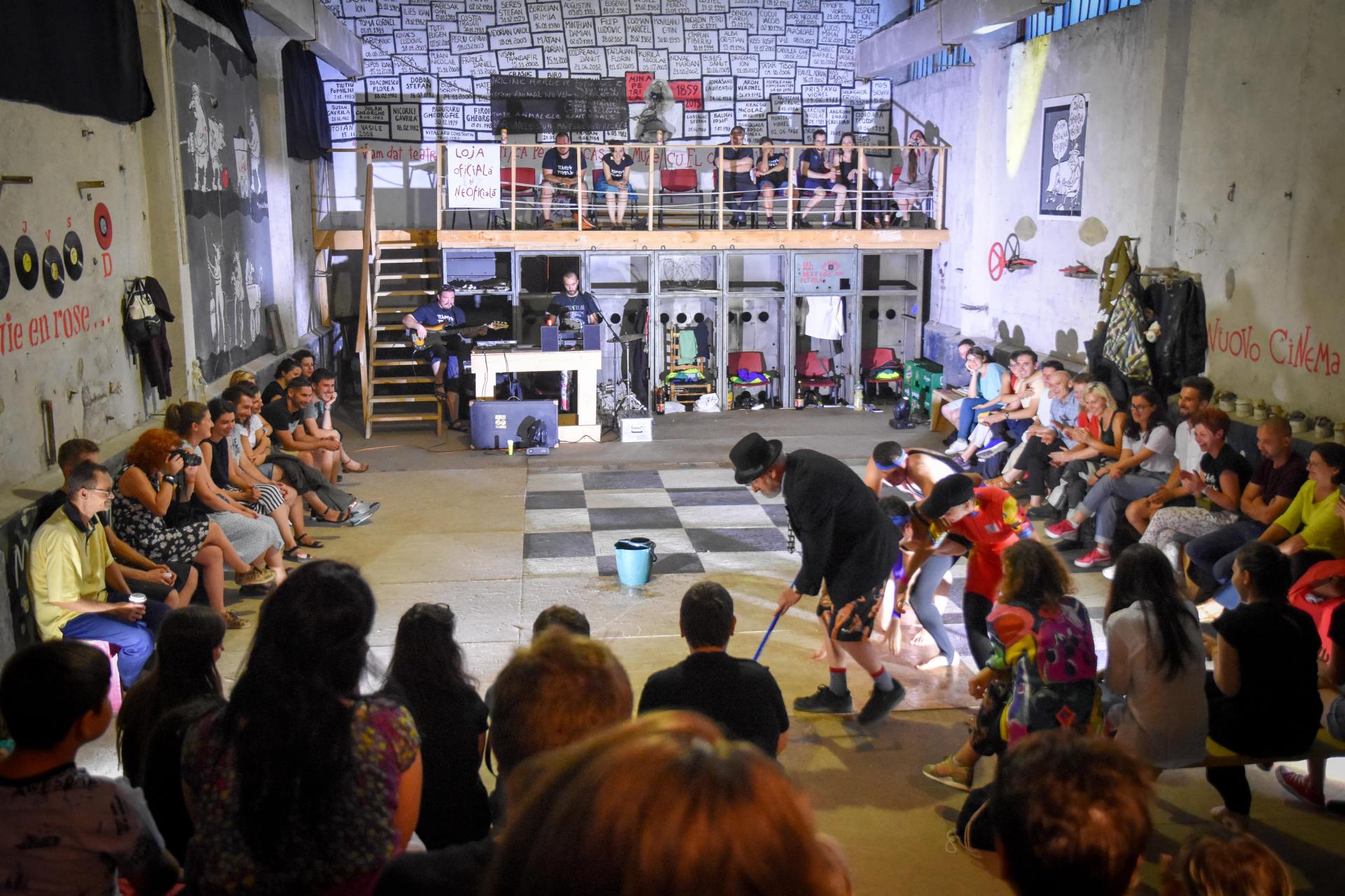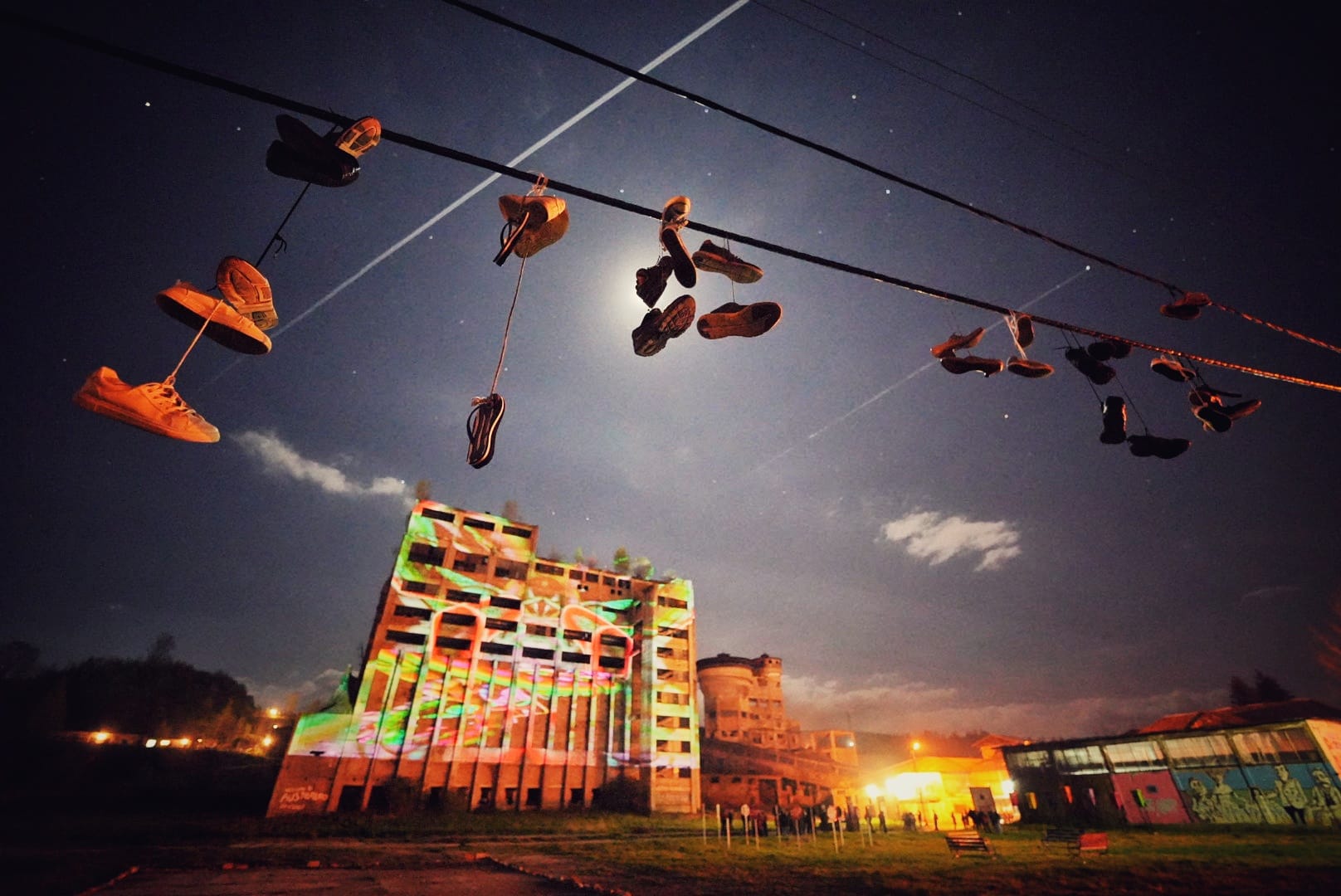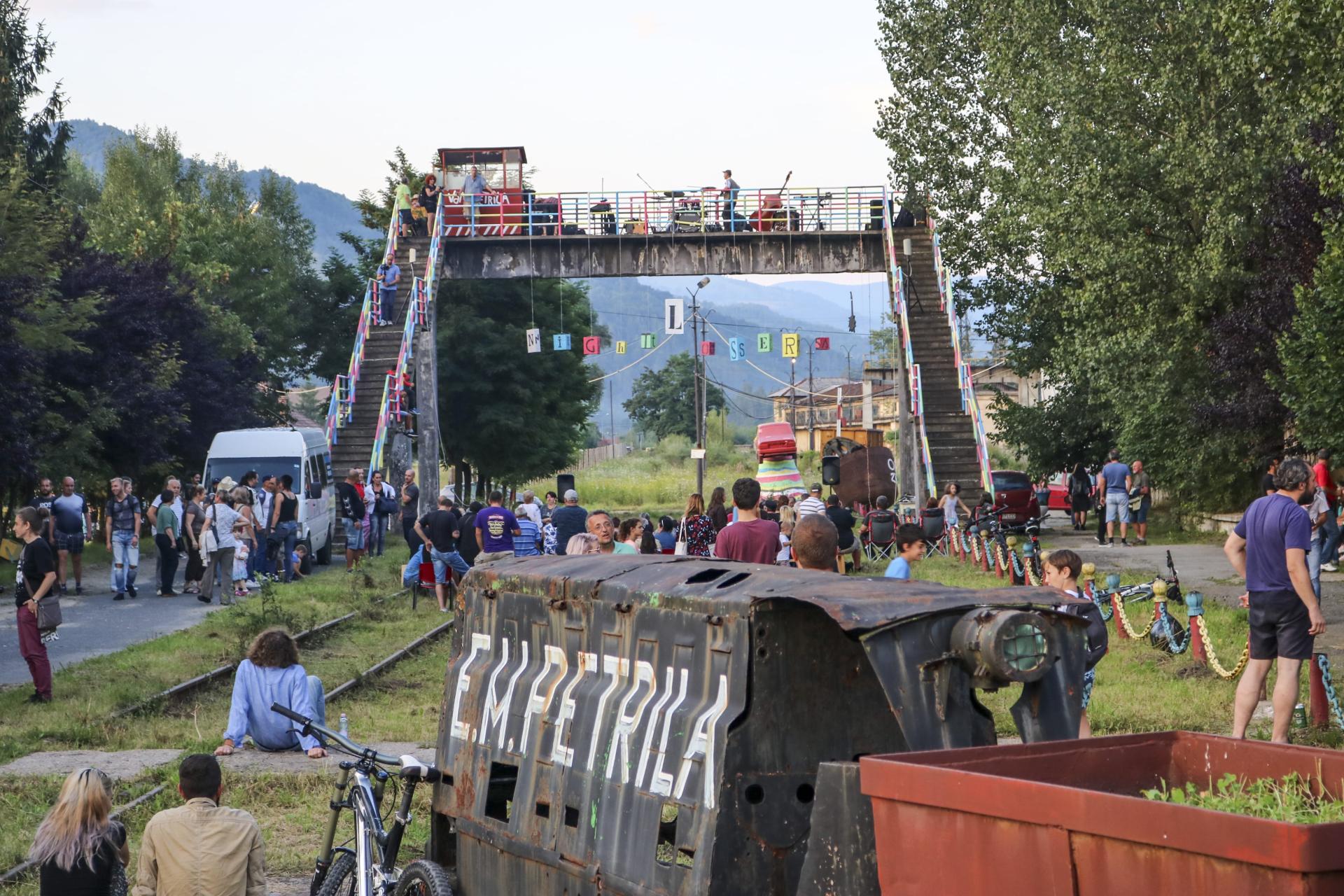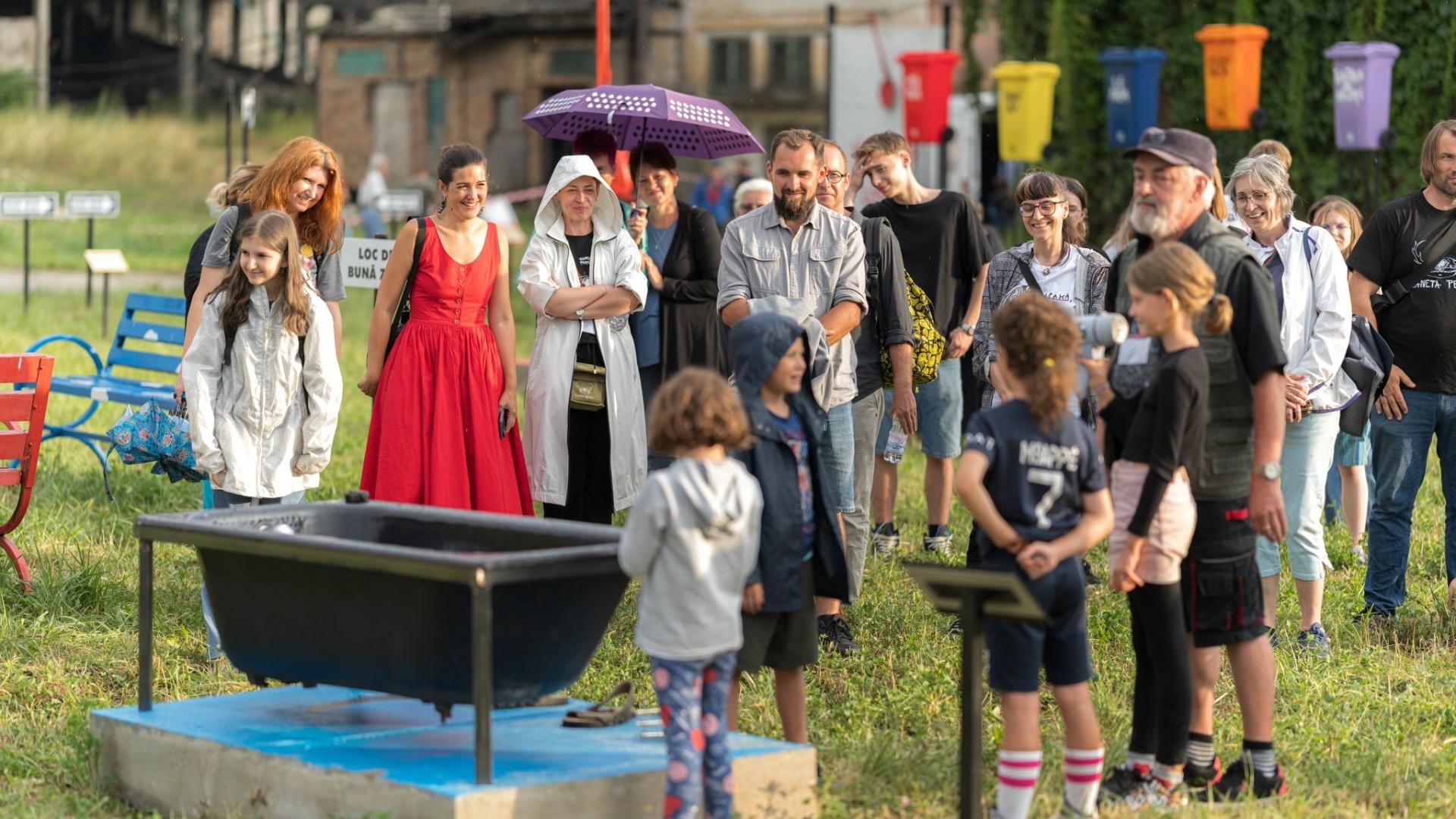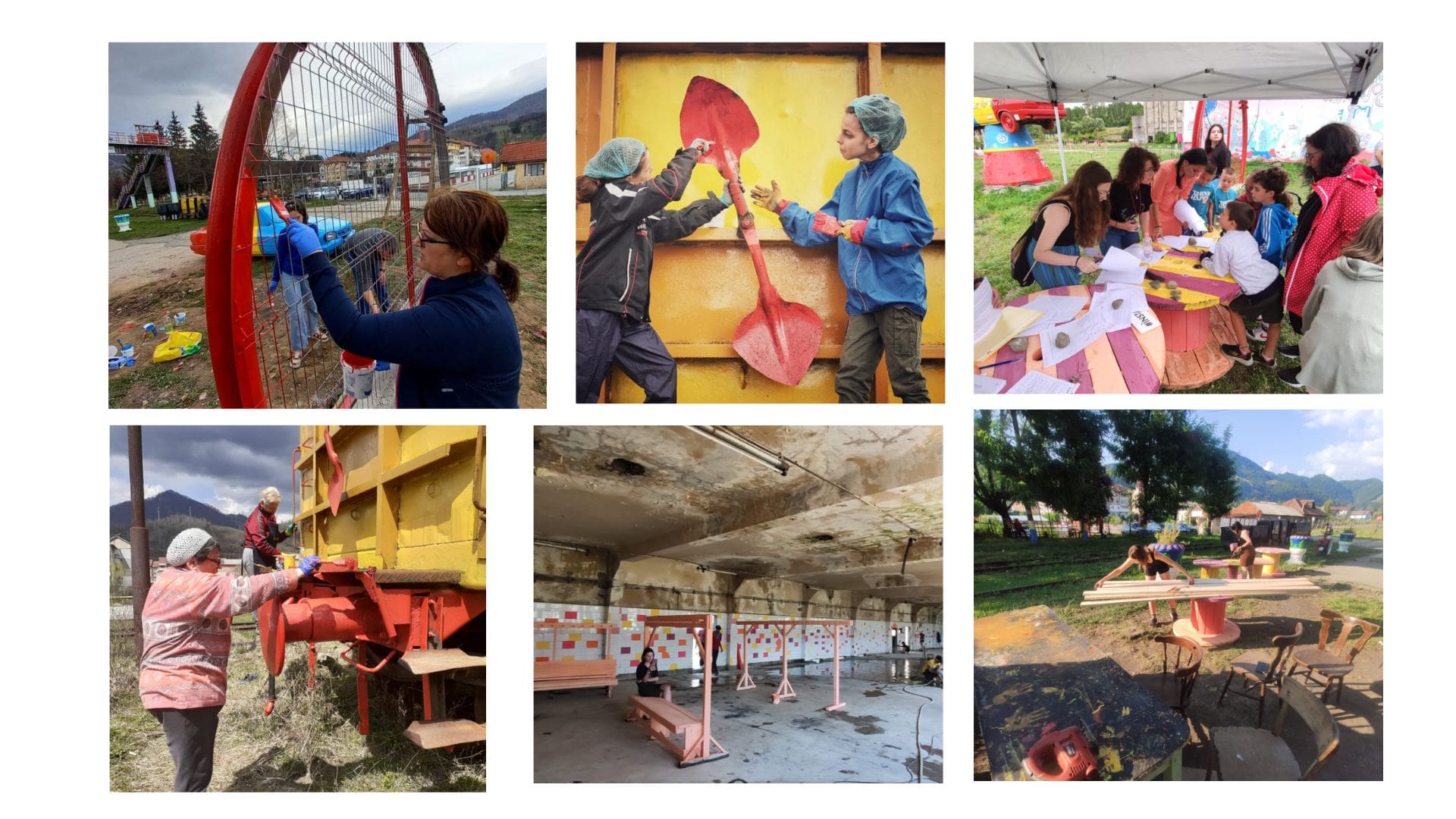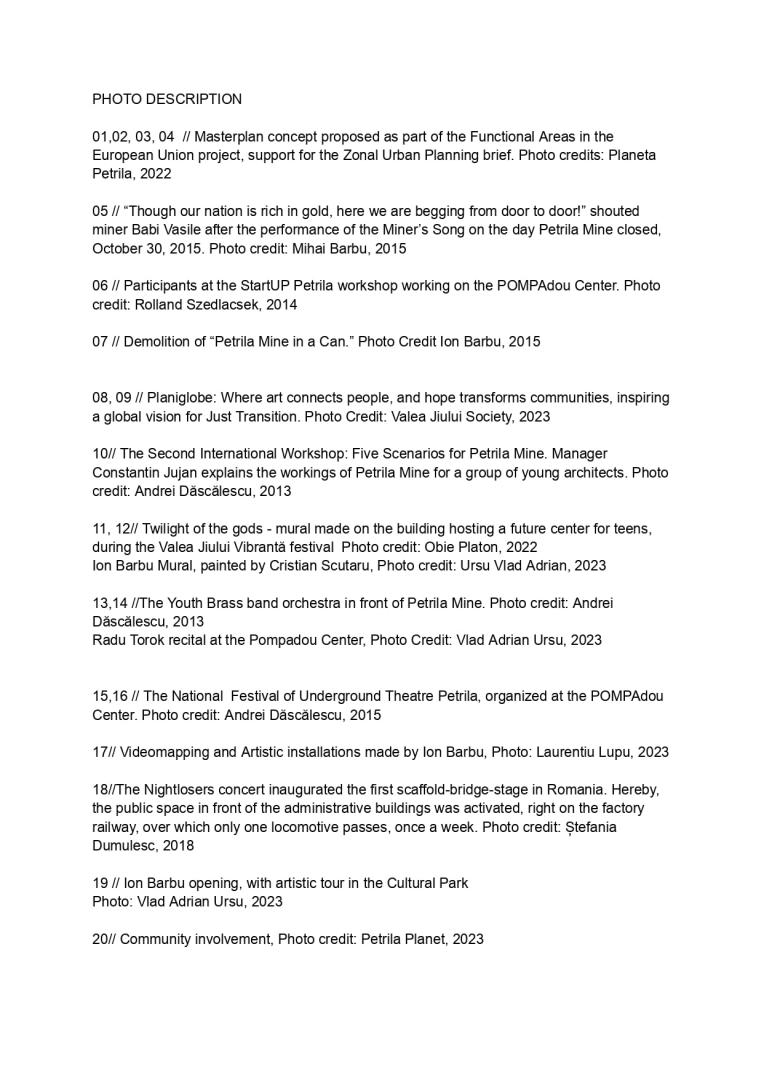Petrila Planet's Cultural Exploitation
Basic information
Project Title
Petrila Planet's Cultural Exploitation
Full project title
Planeta Petrila (Planet Petrila) - Urban Regeneration Masterplan for Petrila Cultural Exploitation
Category
Regaining a sense of belonging
Project Description
The project embodies the inspiring transformation of a small town in Jiu Valley (RO), from a mining-based and male-driven economy, to one that is greener and gender-balanced. Driven by enthusiastic change agents, a Masterplan was co-developed with the aim of reinventing the former coal mine as Petrila Cultural Exploitation - a beautiful, sustainable, inclusive central stage, firmly anchored in the residents’ memory and fostering a sense of belonging among artists, entrepreneurs and inhabitants.
Geographical Scope
Local
Project Region
City of Petrila from Hunedoara county , Romania
Urban or rural issues
Mainly urban
Physical or other transformations
It refers to other types of transformations (soft investment)
EU Programme or fund
No
Description of the project
Summary
Planeta Petrila is a cultural current committed to the urban regeneration of Petrila, a town from Hunedoara County, classified as a Just Transition (JT) area because it hosts the Petrila Coal Mine. This movement is as an innovation and a one-of-a-kind endeavor, as it demonstrates how art, under the creative work of Ion Barbu (former miner that worked in Petrila Mine), bolstered the civic spirit of the local community while also attracting the proactive engagement of local and (inter)national experts who formed deep connections with Petrila through their involvement in the Planeta Petrila initiative. For the past 13 years, Planeta Petrila has infused a fresh sense of purpose into the former mining town, progressively enhancing its beauty, sustainability and inclusivity. It has successfully reinstated a sense of belonging for the local inhabitants (predominantly miners and their families), who were at risk of losing their identity when the coal mine shut down in the course of transitioning toward a green local economy in line with EDG. Within the context of cultural revitalization amid the Just Transition, Planeta Petrila Association, together with experts and the local community, has developed the Urban Regeneration Masterplan for Petrila Cultural Exploitation, which was endorsed by the Petrila City Hall and Hunedoara County Council, with technical support from World Bank. Its aim is to restore the sense of belonging to the citizens by preserving the industrial heritage of the former coal mine, reinvigorating the town's identity and creating a sustainable source of income for the community. The Masterplan is now the cornerstone for transforming Petrila Mine into a socio-economic hub that extends its influence across the wider Jiu Conurbation JT region, setting an international precedent for similar JT areas. It targets the local community, the public administration, domestic entrepreneurs and foreign investors, as well as anyone with emotionally bonded to Petrila.
Key objectives for sustainability
Recognizing the positive impact of Planeta Petrila's artistic influence on the former mine, the public administration, in collaboration with the civic society and various experts, developed this Masterplan to transform the Petrila Mine, the oldest mining operation in Jiu Valley, into a sustainable and vibrant development and cultural hub for the community. The objective is to create a future for Petrila that is sustainable, prosperous and environmentally friendly. The Masterplan includes existing art installations and repurposed buildings, plus proposals to turn Planeta Petrila into an eco-conscious development center for the entire county. It also encompasses additional art installations, cultural amenities, infrastructure revitalization, private usage areas, business development spaces, a robotics hub and green energy generation areas, including a solar panel farm.
It includes multiple exemplary items of environmental sustainability. Its focus falls on reusing existing structures to host new economic and cultural uses, while maintaining and expanding green areas and generating renewable energy on site. The emissions-free, energy-positive complex of rehabilitated buildings, spaces, and cultural installations will sustain the city’s gradual and sustainable revitalization and provide a perpetual source of revenue for the community (similar to how the Merry Cemetery in Săpânța does for the community there). Petrila Mine will be not only a place of memory and historical values, but a catalyst for CO2-free reinvention, with the potential to accelerate the transition of the whole region from polluting industries to a clean and resilient economy.
Planeta Petrila already is one of the best known and most dynamic cultural hubs in Romania (a remarkable feat for a small declining mining town), and it has the promise of becoming one of the most important development hubs for the wider Jiu Valley area and Jiu Conurbation - one of the most important JT catalysts in the region.
It includes multiple exemplary items of environmental sustainability. Its focus falls on reusing existing structures to host new economic and cultural uses, while maintaining and expanding green areas and generating renewable energy on site. The emissions-free, energy-positive complex of rehabilitated buildings, spaces, and cultural installations will sustain the city’s gradual and sustainable revitalization and provide a perpetual source of revenue for the community (similar to how the Merry Cemetery in Săpânța does for the community there). Petrila Mine will be not only a place of memory and historical values, but a catalyst for CO2-free reinvention, with the potential to accelerate the transition of the whole region from polluting industries to a clean and resilient economy.
Planeta Petrila already is one of the best known and most dynamic cultural hubs in Romania (a remarkable feat for a small declining mining town), and it has the promise of becoming one of the most important development hubs for the wider Jiu Valley area and Jiu Conurbation - one of the most important JT catalysts in the region.
Key objectives for aesthetics and quality
Being a decommissioned, non-functional site, Petrila Mine and its host town face urban degradation, out-migration, demographic decline and aging. To address these adverse JT consequences, Planeta Petrila, led by Ion Barbu, has undertaken a series of artistic initiatives (mural paintings, street and asphalt art, absurdist artistic expressions, informal museums, music, theater and literary festivals). One of the recent works, the Planiglobe, seeks to establish artistic connections with individuals who left Petrila in recent years and with those who formed emotional ties to the region, despite not being native to it. Thus, over the years, Barbu has played a pivotal role in countering Petrila's decline following the mine's closure by developing and inspiring various socio-cultural initiatives. Drawing from this rich artistic heritage and aiming to enrich people's experiences, the Masterplan incorporates a noteworthy aesthetic dimension rooted in the transformation of the industrial site, by blending beauty with functionality. It embraces and elevates all these past initiatives and introduces the MInA concept (Museum of Industry and Contemporary Art). MinA will occupy a portion of the mining site (the compressor station, sorting station and funicular), which will be revitalized and repurposed. It will serve as a platform for generating new emotional and cultural benefits through art, fostering unconventional event and exhibition spaces. This space will not only generate additional revenue but will also showcase local artistic creativity, assisting the local community and any visitors in grasping and appreciating the beauty and emotion arising from the artistic spirit that was conceived, nurtured and displayed within Petrila Cultural Exploitation. Thus, the Masterplan will establish a genuine, distinctive development and cultural center and potentially become a consistent source of income for the community, primarily through increased tourism and new economic activities.
Key objectives for inclusion
To date, all the initiatives within Planeta Petrila focused on creating an inclusive local stage for development. They have been tailored to cater to the local community and bring happiness to everyone, being free of charge and often located in easily reachable places, such as the former mineyard. They gave citizens a new sense, from mere consumers of culture, to its active co-creators: in many of his works, Ion Barbu invites the community, particularly children, to participate directly, whether it's preparing materials or even contributing to certain aspects of his works.
This principle of inclusion will be furtherly extended through the Masterplan, which advances the concept of accessibility for all. The spaces foreseen in the Masterplan will be designed to be easily accessible for individuals with disabilities and the facilities will be affordable, fostering the participation of local entrepreneurs and small businesses, while also attracting larger investors. The economic benefits are intended to extend beyond direct ones (additional income/higher wages), through spill-over effects, such as serving as a source of inspiration for aspiring young entrepreneurs and offering opportunities for learning and best practices for local businesses.
The commitment to inclusivity in design doesn't stop there. The spaces will celebrate diversity, both in terms of artistic expression and in the convergence of art, science and business. They will facilitate intergenerational experiences, inviting individuals of all ages to collectively appreciate the local creative offerings while simultaneously engaging several generations of entrepreneurs in the local economic development. Additionally, through its mission to unite the local people and external partners, it will mitigate any tendencies of spatial segregation and isolation. Instead, it will serve as a focal point for social, cultural and economic collaboration in Petrila, the Jiu Valley and the entire Jiu Conurbation.
This principle of inclusion will be furtherly extended through the Masterplan, which advances the concept of accessibility for all. The spaces foreseen in the Masterplan will be designed to be easily accessible for individuals with disabilities and the facilities will be affordable, fostering the participation of local entrepreneurs and small businesses, while also attracting larger investors. The economic benefits are intended to extend beyond direct ones (additional income/higher wages), through spill-over effects, such as serving as a source of inspiration for aspiring young entrepreneurs and offering opportunities for learning and best practices for local businesses.
The commitment to inclusivity in design doesn't stop there. The spaces will celebrate diversity, both in terms of artistic expression and in the convergence of art, science and business. They will facilitate intergenerational experiences, inviting individuals of all ages to collectively appreciate the local creative offerings while simultaneously engaging several generations of entrepreneurs in the local economic development. Additionally, through its mission to unite the local people and external partners, it will mitigate any tendencies of spatial segregation and isolation. Instead, it will serve as a focal point for social, cultural and economic collaboration in Petrila, the Jiu Valley and the entire Jiu Conurbation.
Results in relation to category
Planeta Petrila is another planet - unlike anything you have seen, shaped by its industrial legacy, by the vision of local geniuses and by the tireless involvement of the wider community. It is a manifestation of a community’s will to not be forgotten and not go down quietly in the night.
Following the same spirit of Planeta Petrila, the Masterplan is a one-of-the-kind project. The impact achieved thus far is the establishment of a cohesive community comprising residents, organizations, businesses, local, county and national government authorities, independent experts and international partners. They all share a common aspiration – the transformation of Petrila's Mining Exploitation into Petrila Cultural Exploitation, brought to life through an extensive urban regeneration process encapsulated in the Masterplan. Its impact, aimed at infusing the Petrila Mine with new meaning and regaining a sense of belonging within its surrounding community, is reflected in the following achievements up to this point (culminating in the finalization of the Masterplan and its presentation to decision-makers):
- 27 experts, 820 citizens, 26 local partners (NGOs and companies), 3 universities, 2 local public administrations, 5 national Ministries, 3 international organizations involved in co-developing the Masterplan
- 16 awareness and promotion events
- 6 multidisciplinary local and (inter)national workshops, through which renewal studies and future scenarios for the Petrila Mine were co-developed
- 8 local and national exhibitions, giving a new meaning to the mine: Petrila Culture Mining, Shrinking Cities
- 1 historical study for mine’s classification as a historical monument
- 1 pilot participative intervention for transforming the local historical heritage: the conversion of the former pumphouse in a cultural space
- INP FUNDING from Stamp of Historical Monuments
Following the same spirit of Planeta Petrila, the Masterplan is a one-of-the-kind project. The impact achieved thus far is the establishment of a cohesive community comprising residents, organizations, businesses, local, county and national government authorities, independent experts and international partners. They all share a common aspiration – the transformation of Petrila's Mining Exploitation into Petrila Cultural Exploitation, brought to life through an extensive urban regeneration process encapsulated in the Masterplan. Its impact, aimed at infusing the Petrila Mine with new meaning and regaining a sense of belonging within its surrounding community, is reflected in the following achievements up to this point (culminating in the finalization of the Masterplan and its presentation to decision-makers):
- 27 experts, 820 citizens, 26 local partners (NGOs and companies), 3 universities, 2 local public administrations, 5 national Ministries, 3 international organizations involved in co-developing the Masterplan
- 16 awareness and promotion events
- 6 multidisciplinary local and (inter)national workshops, through which renewal studies and future scenarios for the Petrila Mine were co-developed
- 8 local and national exhibitions, giving a new meaning to the mine: Petrila Culture Mining, Shrinking Cities
- 1 historical study for mine’s classification as a historical monument
- 1 pilot participative intervention for transforming the local historical heritage: the conversion of the former pumphouse in a cultural space
- INP FUNDING from Stamp of Historical Monuments
How Citizens benefit
Petrila's JT journey reveals a population facing few opportunities but many problems, due to its low capacity to adapt to the new economic, social and environmental trends. The former miners and their struggle to adjust to these shifts inspired Planeta Petrila’s mission: a movement for and about people – their history, challenges and potential for salvation.The Masterplan embodies and furtherly strengthens this motto, transforming it into a governing principle, emphasizing participatory and mutually-reinforcing development through co-design for all.
Citizens played an integral role in formulating the Masterplan. Initially, our document emerged from the local population’s need to transit from a predominantly male-driven, polluting economy to a greener one, where the voices and influence of women and young people are more prominent. Then, to ensure the Masterplan effectively addresses its intended beneficiaries’ concerns, various local experts contributed to it. Public consultations were also conducted to gather community input on the pursued vision. Lastly, the document was shared for public scrutiny, enabling citizens, entrepreneurs, civil servants and other local parties to understand the envisioned future for Petrila through the regeneration of the Cultural Exploitation+provide feedback on its alignment with the community's and local ecosystem’s perspective. The final version with all the gathered insights was presented to the public administration for implementation.
Incorporating citizens’ voices in the Masterplan permitted the creation of an integrated concept that harmonizes their aspirations.The Masterplan’s intended impact is to transform the former Petrila Mine into a hub for economic and socio-cultural development, creating the grounds for a greener economy, fostering social and cultural vibrancy, offering opportunities for the local people+organizations and sowing the seeds for a new societal model where everybody can equally generate the needed change.
Citizens played an integral role in formulating the Masterplan. Initially, our document emerged from the local population’s need to transit from a predominantly male-driven, polluting economy to a greener one, where the voices and influence of women and young people are more prominent. Then, to ensure the Masterplan effectively addresses its intended beneficiaries’ concerns, various local experts contributed to it. Public consultations were also conducted to gather community input on the pursued vision. Lastly, the document was shared for public scrutiny, enabling citizens, entrepreneurs, civil servants and other local parties to understand the envisioned future for Petrila through the regeneration of the Cultural Exploitation+provide feedback on its alignment with the community's and local ecosystem’s perspective. The final version with all the gathered insights was presented to the public administration for implementation.
Incorporating citizens’ voices in the Masterplan permitted the creation of an integrated concept that harmonizes their aspirations.The Masterplan’s intended impact is to transform the former Petrila Mine into a hub for economic and socio-cultural development, creating the grounds for a greener economy, fostering social and cultural vibrancy, offering opportunities for the local people+organizations and sowing the seeds for a new societal model where everybody can equally generate the needed change.
Physical or other transformations
It refers to other types of transformations (soft investment)
Innovative character
Planeta Petrila is truly a wonder that has evolved organically through grassroots efforts and the wide involvement of the community. The Masterplan possesses a distinct and innovative character as it encapsulates, in a single comprehensive document, the culmination of 13 years of work within a continuous cultural movement. It stands as an independent project that consolidates and translates all the efforts carried out under the umbrella of Planeta Petrila into a novel urban development model. If implemented, this model has the potential to become the driving force behind the systemic, co-participative transformation of Petrila, Hunedoara County, the Jiu Valley and the entire Jiu Conurbation.
Developed within the Planeta Petrila movement, the Masterplan serves as a testament on how the collective efforts of the local community and the broader local ecosystem, coupled with national and international support, can restore the sense of belonging among local residents. Moreover, it reinvigorates and gives a new meaning to a degraded industrial space – the oldest mining operation in the Jiu Valley, who will become a unique hub, that will foster diversity and innovation through a process of creative and integrated regeneration. As a result, Petrila Cultural Exploitation shows that, by adapting the local historical heritage to the contemporary dynamics and positively repurposing it, the regenerative process proposed in the Masterplan could reignite local vitality on multiple areas, inspiring new forward-looking ambitions through collaboration and active participation.
As such, the Urban Regeneration Masterplan for Petrila Cultural Exploitation is the culmination of a creative and interdisciplinary endeavor, that connects the former Petrila Mine to the European Green Deal, facilitating the local transition towards a future characterized by visual beauty, emotional fulfillment and intellectual stimulation.
Developed within the Planeta Petrila movement, the Masterplan serves as a testament on how the collective efforts of the local community and the broader local ecosystem, coupled with national and international support, can restore the sense of belonging among local residents. Moreover, it reinvigorates and gives a new meaning to a degraded industrial space – the oldest mining operation in the Jiu Valley, who will become a unique hub, that will foster diversity and innovation through a process of creative and integrated regeneration. As a result, Petrila Cultural Exploitation shows that, by adapting the local historical heritage to the contemporary dynamics and positively repurposing it, the regenerative process proposed in the Masterplan could reignite local vitality on multiple areas, inspiring new forward-looking ambitions through collaboration and active participation.
As such, the Urban Regeneration Masterplan for Petrila Cultural Exploitation is the culmination of a creative and interdisciplinary endeavor, that connects the former Petrila Mine to the European Green Deal, facilitating the local transition towards a future characterized by visual beauty, emotional fulfillment and intellectual stimulation.
Disciplines/knowledge reflected
Planeta Petrila, while initiated by Ion Barbu (former miner and artist), evolved as a multifaceted initiative drawing from various sources of creativity, through contributions from diverse artists (musicians, sculptors, poets, cartoonists), experts (urban planners, ecologists) and interested parties who joined the movement (public administration, local entrepreneurs), all with the local community’s involvement.
This same spirit of transdisciplinarity substantiates the Masterplan. In its development, we engaged many practitioners to harmonize knowledge from diverse fields. Initially, we relied on input from residents (particularly miners), who possess an intimate understanding of the local context. Then, we consulted with local NGOs that are close to our local community. Furtherly, we included specialists from various fields in the Masterplan's development, spanning urban planning, architecture, landscaping, economics, sociology, environment, climate, energy, engineering, topography, material testing, excavation research, NTD, geotechnics, RDI, academia (universities in Paris, Bucharest, Cluj, Iași, Timișoara), culture, history and law. Various artists contributed to shaping the concept of the Museum of Industry and Contemporary Art (MinA).International organizations with relevant expertise (Bankwatch for environmental protection, GreenPeace for green energy and climate change) offered guidance according to their profiles.We leveraged the affiliations established by Planeta Petrila Association, to draw knowledge from external sources and apply it within Petrila.
As a final outcome, the Masterplan embodies this transdisciplinary approach: it comprises a cultural and artistic facet (the MinA), an RDI component (the creativity and innovation center designed around a robotics hub in collaboration with the Petroșani University and local schools) and a business dimension (the production and manufacturing section allocated to the Valea Jiului Industrial and Business Park)
This same spirit of transdisciplinarity substantiates the Masterplan. In its development, we engaged many practitioners to harmonize knowledge from diverse fields. Initially, we relied on input from residents (particularly miners), who possess an intimate understanding of the local context. Then, we consulted with local NGOs that are close to our local community. Furtherly, we included specialists from various fields in the Masterplan's development, spanning urban planning, architecture, landscaping, economics, sociology, environment, climate, energy, engineering, topography, material testing, excavation research, NTD, geotechnics, RDI, academia (universities in Paris, Bucharest, Cluj, Iași, Timișoara), culture, history and law. Various artists contributed to shaping the concept of the Museum of Industry and Contemporary Art (MinA).International organizations with relevant expertise (Bankwatch for environmental protection, GreenPeace for green energy and climate change) offered guidance according to their profiles.We leveraged the affiliations established by Planeta Petrila Association, to draw knowledge from external sources and apply it within Petrila.
As a final outcome, the Masterplan embodies this transdisciplinary approach: it comprises a cultural and artistic facet (the MinA), an RDI component (the creativity and innovation center designed around a robotics hub in collaboration with the Petroșani University and local schools) and a business dimension (the production and manufacturing section allocated to the Valea Jiului Industrial and Business Park)
Methodology used
The Masterplan is grounded in a co-design process, representing the outcome of collaborative efforts involving numerous experts from diverse fields. These experts adapted international recommendations garnered through consultations with various stakeholders to local knowledge. Consequently, the endeavor unfolded on multiple fronts, starting with insights from the local community and gradually constructing an integrated concept, which was embraced by the public administration and subjected to discussions at various levels of authority – local, county, national.
Our methodology can be likened to an x-ray, revealing the expectations of the local population and the projections of specialists concerning Petrila Mine’s functional reconfiguration. In doing so, it delineates an entirely new local identity. Originating from individual artistic expressions and a collective sense of disappointment in response to the mine's closure, this bottom-up process has became a final product that will align the local industrial heritage to the EU ambition of transitioning to a green, inclusive and carbon-free economy.
Petrila Cultural Exploitation will offer resources to a multiple individuals and entities, through spaces designed to European standards, artistic exhibition through the MInA museum, a hub for researchers and innovators through the RDI center and opportunities for local businesses and external investors through the logistic and business facilities. The effective implementation of the Masterplan has the potential to propel Petrila and the entire Jiu Valley, which face some of the most pressing socio-economic transitions in the EU, closer to the more developed regions, while simultaneously restoring the sense of belonging to all its inhabitants, be they residents, entrepreneurs, researchers or artists. By bridging diverse backgrounds, the Masterplan will spearhead the regeneration of the Petrila Mine and its surrounding area, ultimately reviving the community’s spirit.
Our methodology can be likened to an x-ray, revealing the expectations of the local population and the projections of specialists concerning Petrila Mine’s functional reconfiguration. In doing so, it delineates an entirely new local identity. Originating from individual artistic expressions and a collective sense of disappointment in response to the mine's closure, this bottom-up process has became a final product that will align the local industrial heritage to the EU ambition of transitioning to a green, inclusive and carbon-free economy.
Petrila Cultural Exploitation will offer resources to a multiple individuals and entities, through spaces designed to European standards, artistic exhibition through the MInA museum, a hub for researchers and innovators through the RDI center and opportunities for local businesses and external investors through the logistic and business facilities. The effective implementation of the Masterplan has the potential to propel Petrila and the entire Jiu Valley, which face some of the most pressing socio-economic transitions in the EU, closer to the more developed regions, while simultaneously restoring the sense of belonging to all its inhabitants, be they residents, entrepreneurs, researchers or artists. By bridging diverse backgrounds, the Masterplan will spearhead the regeneration of the Petrila Mine and its surrounding area, ultimately reviving the community’s spirit.
How stakeholders are engaged
Over time, Ion Barbu has engaged various multi-level contributors within Planeta Petrila’s efforts. Initially, the movement was instigated by Barbu, a local resident with a vision to redefine Petrila – shifting it from a mining-focused community to a hub for cultural exploration. He engaged hundreds of individuals in this ambitious regeneration endeavor, starting with the local community (friends, neighbors, former mine colleagues), then collaborating with various local experts (architects, ecologists) and artists. Subsequently, he succeeded in gaining support from the public administration to back this pursuit, ultimately attracting numerous (inter)national experts and artists along the journey. As of today, Planeta Petrila garnered attention and support from various Romanian Ministries, the European Commission, the World Bank and international organizations (GreenPeace, Bankwatch).
Acknowledging the positive impact of this model on Petrila and the broader Jiu Valley and Jiu Conurbation, we decided to follow a similar approach in developing the Masterplan. Our process began with horizontal consultations with citizens, involving local experts and collaborating closely with the public administration in Petrila and later in Hunedoara County. As the Masterplan was developed, dozens of (inter)national experts were actively engaged, with some providing consultation and others contributing directly to its content. We conducted consultations with relevant Ministries to introduce and discuss our vision and we sought feedback from European institutions, while also receiving technical assistance from the World Bank. This comprehensive approach ensured alignment of our local vision with EU requirements and international standards, creating a framework that, while primarily local, will have a regional impact and generate positive effects for similar JT regions in Romania and Europe that share this broader vision – one of creating a beautiful, sustainable and inclusive future.
Acknowledging the positive impact of this model on Petrila and the broader Jiu Valley and Jiu Conurbation, we decided to follow a similar approach in developing the Masterplan. Our process began with horizontal consultations with citizens, involving local experts and collaborating closely with the public administration in Petrila and later in Hunedoara County. As the Masterplan was developed, dozens of (inter)national experts were actively engaged, with some providing consultation and others contributing directly to its content. We conducted consultations with relevant Ministries to introduce and discuss our vision and we sought feedback from European institutions, while also receiving technical assistance from the World Bank. This comprehensive approach ensured alignment of our local vision with EU requirements and international standards, creating a framework that, while primarily local, will have a regional impact and generate positive effects for similar JT regions in Romania and Europe that share this broader vision – one of creating a beautiful, sustainable and inclusive future.
Global challenges
Global challenges tackled by the Masterplan:
AGING:The Masterplan and its proposed interventions (architectural, environmental,cultural, entrepreneurial) focus on remaking Petrila attractive,especially for young people or digital nomads, slowing down its depopulation and aging.
POVERTY:Addressing the increasing poverty that followed the decline of the coal industry was a focal point of the Masterplan; by setting the foundation for attracting non-polluting industrial activities, cultural and creative industries, RDI&ITC investment, it aims to create new, better paid jobs.
CLIMATE CHANGE:The former mine was one of the largest energy consumers , a major urban heat island, generating significant GHG emissions and pollution. Interventions included here aim to gradually transform the area in a positive energy district, also encouraging alternative mobility.
SUSTAINABLE DEVELOPMENT:The Masterplan’s setting is a brownfield area with historical pollution problems. Regeneration sets the ambition of making the area frequentable to all by reducing air, water and soil pollution and waste, encouraging recycling and reuse ofmaterials, expanding green areas and creating a green-blue corridor.
DEMOCRATIZATION:One of the Masterplan’s most valuable outcomes is the success of creating a strong local ecosystem of change agents, by using co-design tools; this ecosystem is growing and is involved in most of local decision making processes.
GENDER INEQUALITY, YOUTH OPPORTUNITIES: In a mining town where most women were housewives, the Masterplan brings a fresh approach that creates multiple opportunities for them to learn, share, express themselves and achieve a fair work-life balance. It also places a premium on getting young people involved, a key way to stem out-migration.
The urban renewal process covered by the Masteplan will transform the entire urban landscape, identity and energy.People feel, after many years, that there is hope and that they don’t live in a forgotten place.
AGING:The Masterplan and its proposed interventions (architectural, environmental,cultural, entrepreneurial) focus on remaking Petrila attractive,especially for young people or digital nomads, slowing down its depopulation and aging.
POVERTY:Addressing the increasing poverty that followed the decline of the coal industry was a focal point of the Masterplan; by setting the foundation for attracting non-polluting industrial activities, cultural and creative industries, RDI&ITC investment, it aims to create new, better paid jobs.
CLIMATE CHANGE:The former mine was one of the largest energy consumers , a major urban heat island, generating significant GHG emissions and pollution. Interventions included here aim to gradually transform the area in a positive energy district, also encouraging alternative mobility.
SUSTAINABLE DEVELOPMENT:The Masterplan’s setting is a brownfield area with historical pollution problems. Regeneration sets the ambition of making the area frequentable to all by reducing air, water and soil pollution and waste, encouraging recycling and reuse ofmaterials, expanding green areas and creating a green-blue corridor.
DEMOCRATIZATION:One of the Masterplan’s most valuable outcomes is the success of creating a strong local ecosystem of change agents, by using co-design tools; this ecosystem is growing and is involved in most of local decision making processes.
GENDER INEQUALITY, YOUTH OPPORTUNITIES: In a mining town where most women were housewives, the Masterplan brings a fresh approach that creates multiple opportunities for them to learn, share, express themselves and achieve a fair work-life balance. It also places a premium on getting young people involved, a key way to stem out-migration.
The urban renewal process covered by the Masteplan will transform the entire urban landscape, identity and energy.People feel, after many years, that there is hope and that they don’t live in a forgotten place.
Learning transferred to other parties
Planeta Petrila is an example that change is possible even in the most deprived areas and can serve as an example and inspiration to Just Transition areas from around the globe. This approach has already been replicated throughout the Jiu Valley area, in Lupeni, Aninoasa, Vulcan and Lonea.
The entire urban renewal Masterplan can be used as an intervention model for other cities facing similar deficiencies regarding the preservation, safeguarding and functional conversion of existing mining buildings/sites. A Masterplan is a wonderful tool not just setting a future vision for an area, but it is also an excellent tool for bringing various stakeholders around the table and an amazing vehicle for mobilizing financing (money comes where a concrete use can be found for it).
The methodology we have employed, characterized by its grassroots orientation and hands-on approach, grounded in multidisciplinary reactivity, is adaptable to any community with similar needs and the studies conducted throughout this process can serve as a foundational framework for conducting similar analyses in other regions.
The Masterplan for the mine already serves as a best practice model for two other mining complexes in the region, due to be closed by 2026.
More than anything, though, Planeta Petrila is an example that if you can make it there, you can make it anywhere, as there are few sites that have faced the difficulties and challenges that Petrila has faced. The Planeta Petrila Association is open to passing on, to any interested actors (be it a citizen, NGO, public administration, urban planner and so on) all the knowledge generated within this extensive process of reviving a former industrial site and transforming it in a place of inclusion, sustainability and aesthetics, with the wide involvement of the community. The Association could even share its establishment/organization processes and current functioning.
The entire urban renewal Masterplan can be used as an intervention model for other cities facing similar deficiencies regarding the preservation, safeguarding and functional conversion of existing mining buildings/sites. A Masterplan is a wonderful tool not just setting a future vision for an area, but it is also an excellent tool for bringing various stakeholders around the table and an amazing vehicle for mobilizing financing (money comes where a concrete use can be found for it).
The methodology we have employed, characterized by its grassroots orientation and hands-on approach, grounded in multidisciplinary reactivity, is adaptable to any community with similar needs and the studies conducted throughout this process can serve as a foundational framework for conducting similar analyses in other regions.
The Masterplan for the mine already serves as a best practice model for two other mining complexes in the region, due to be closed by 2026.
More than anything, though, Planeta Petrila is an example that if you can make it there, you can make it anywhere, as there are few sites that have faced the difficulties and challenges that Petrila has faced. The Planeta Petrila Association is open to passing on, to any interested actors (be it a citizen, NGO, public administration, urban planner and so on) all the knowledge generated within this extensive process of reviving a former industrial site and transforming it in a place of inclusion, sustainability and aesthetics, with the wide involvement of the community. The Association could even share its establishment/organization processes and current functioning.
Keywords
Reinvention
Development
Just transition
Bottom-up approach
Creativity

